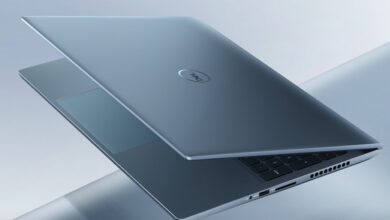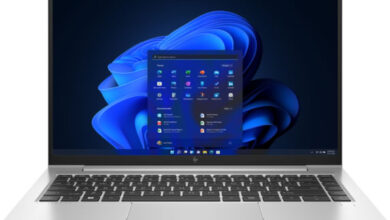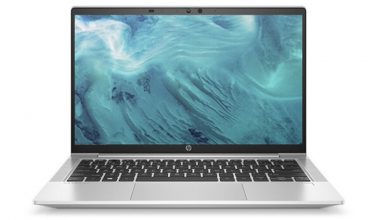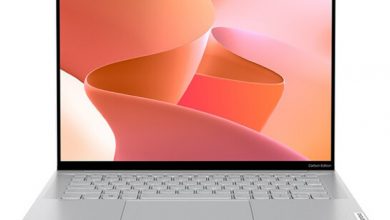Since its official release in 2020, the Lenovo Legion 5i has been performing quite well. It is also a powerful and attractive laptop. However, this year, the company updated the Lenovo Legion 5i with new AMD Ryzen 5-series CPUs and NVIDIA GPUs. We also reviewed the Lenovo Legion 5 Pro, which was released at the same time.
The new Lenovo Legion 5i comes with the latest AMD Ryzen R7-5800H processor and NVIDIA RTX 3060 GPU. It features a 165Hz IPS matte screen, 16GB of RAM, and a 512GB SSD.
Lenovo Legion 5i Specifications
| Screen | 15.6″ FHD (1920 x 1080) IPS, 165Hz refresh rate, <3 ms response time, 100% sRGB, 300 nits, Dolby Vision supported, AMD FreeSync Premium |
| Processor | AMD Ryzen 7 5800H (3.2GHz, up to 4.40GHz, 8 Cores, 16 Threads, 16MB Cache) |
| Wireless Connection | WiFi 6 802.11AX (2 x 2); Bluetooth® 5.1 |
| Graphics card | NVIDIA GeForce RTX3060, 6GB GDDR6, Maximum Graphics Power 130W |
| Memory | 16GB DDR4 3200MHz |
| Storage | 512GB M.2 NVMe PCIe SSD |
| Camera | HD 720p with E-Shutter |
| Ports | USB-C 3.2 Gen 2 (DisplayPort™ 1.4), Headphone/mic combo, USB-A 3.2 Gen 1, E-Shutter button, 3 x USB-A 3.2 Gen 1, USB-C 3.2 Gen 2 (DisplayPort™ 1.4 & power delivery), HDMI 2.1, RJ45, Power input |
| Battery | 80Wh |
| OS | Windows 10 Home |
| Weight | 2.4kg / 5.3lbs |
Lenovo Legion 5i Review: Design and Appearance
The design of the Lenovo Legion 5i is very simple but attractive. The laptop has two logos: the Lenovo logo is located on one side of the top surface, and the LEGION logo is diagonal to the Lenovo logo. The top surface is made of frosted plastic, which feels good in the hand, but the disadvantage is that it easily attracts fingerprints.
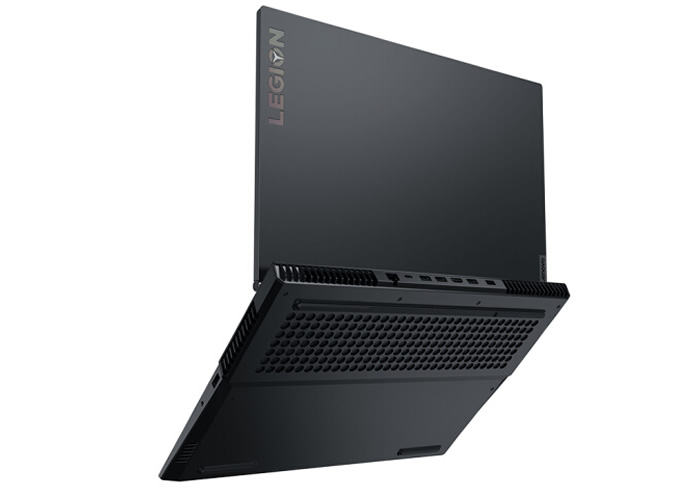
Opening the laptop, we can see that the display has very narrow bezels, especially on the sides, which makes the display more immersive. The display also retains the webcam and supports physical switching. Another attractive feature of this laptop is that it can automatically turn on when the user opens the top cover. This can be set up in Lenovo PC Manager or Lenovo Vantage.
The keyboard area of this notebook is made of matte plastic, and the keyboard is relatively small. In the lower left corner of the notebook, there is a QR code that Lenovo uses to access the service. Next up are stickers for AMD Ryzen, Radeon, and Nvidia GeForce RTX. The power button is located at the top center of the keyboard area, and the touchpad is smooth, which helps with easy navigation.
At the bottom, there is a longer footpad near the air vents and two shorter ones. These pads are used to keep the laptop from sliding off the surface. These pads also elevate the notebook slightly, increasing the airflow from the bottom vents. About 30% to 40% of the entire bottom area is vented. We can see that this laptop takes cooling very seriously.
Lenovo Legion 5i Review: Screen
The laptop comes with a 15.6-inch IPS matte screen with a 1920 x 1080 resolution and a 100% sRGB color gamut, as well as a 165Hz refresh rate.

We used DisplayCal and Blue Spider X to test the screen. It comes with an LP156WFG-SPT2 screen. The sRGB color gamut covers 99.7%, the Adobe RGB color gamut covers 76.2%, and the DCI-P3 color gamut covers 81.2%. The screen quality is very good, and the sRGB color gamut is almost completely covered.
The color accuracy of the display is also another attractive aspect of the device. The screen has a maximum brightness of 359.6 nits and a default color temperature of 6300K. This may appear yellowish to some people. The average color deviation value (Delta E) of the screen is 2.36, and the maximum color deviation value (Delta E) of the screen is 7.48.
However, we observed that Lenovo didn’t calibrate the display’s colors out of the box. Considering this is an uncalibrated display, the numbers are pretty good. The basic quality of this screen is very high, and after self-calibration, it is still capable of simple creative work.
Lenovo Legion 5i: Ports
The device comes with multiple ports on three sides, both sides, and the rear. The left side of the body has a USB-C 3.2 Gen 2 port (DisplayPort 1.4) and a headphone/microphone jack.
The right side has a USB-A 3.2 Gen 1 port, an E-Shutter button (physical camera switch), and a power indicator.
On the rear, there are three USB-A 3.2 Gen 1 ports, a USB-C 3.2 Gen 2 port, an HDMI 2.1 port, an RJ45 jack, and a power input.
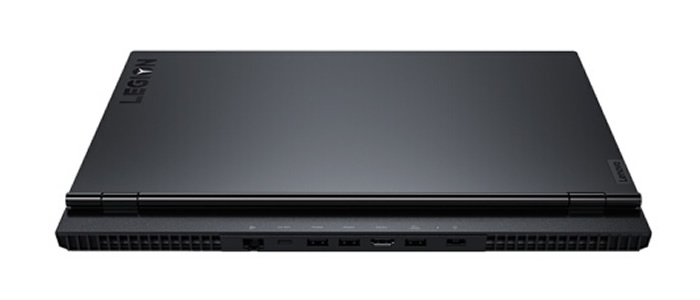
Lenovo Legion 5i: Keyboard
The design of most Legion series keyboards is almost always the same. The Legion 5i is no exception. The keyboard and keycap design maintain a high standard and are well-received in the market. First of all, the device comes with a backlight, and it also uses a Legion TrueStrike keyboard.

The key travel is 1.5 mm, and the keycaps are slightly curved to fit the curvature of your fingers. The round keycaps and a large touchpad make this keyboard even more attractive. The keyboard design is much like the Lenovo Legion 5 Pro keyboard.
Lenovo Legion 5i: CPU and GPU
We use CPU-Z to get the CPU data for the Lenovo Legion 5i AMD version. The laptop is powered by an AMD Ryzen 7 5800H processor, an 8-core, 16-thread CPU launched by AMD in 2021. It has a TDP of 45W and uses a 7nm manufacturing process with 16MB L3 cache.
The Legion 5i uses the GeForce RTX 3060 graphics card. This GPU has 3840 rendering units and is Nvidia’s second-generation graphics card with support for ray tracing.
CineBench R15
We tested the CPU single-core performance in both the laptop’s core display output and the graphics card’s direct output mode using the CineBench R15 platform. According to CineBench R15 testing, these two modes have almost no impact on CPU single-core performance. The scores for both modes are 234 cb and 235 cb, respectively, which can be considered an error.
We also performed 15 rounds of multi-core testing using the CineBench R15. The test results show that in CineBench R15, the CPU multi-core score in the direct mode graphics display is slightly higher than the score in the core display output mode. However, in reality, the difference is so insignificant that most users won’t notice it.
CineBench R20
Using the CineBench R20 to test the CPU single-core performance of the notebook’s core display output and graphics card direct-out mode, the results show that the two modes have almost no difference. This is similar to the situation recorded in the CineBench R15 test. The scores are 560 cb and 562 cb, which can also be regarded as errors.
In the multicore test of CineBench R20, we identified a strange phenomenon. In CineBench R20, the results of the multi-core performance test and the results of CineBench R15 are reversed. The CPU multicore score for the direct graphics output mode is slightly lower than the score for the mode with core graphics output.
We expect the results for R15 and R20 to have the same trend, just different numbers. Currently, we can’t determine why the numbers in these tests are reversed.
GPU
For GPU testing, we used 3DMark to test the laptop in different graphics output modes and different performance modes. We also conducted an accompanying test using Fire Strike Extreme and TimeSpy to compare running scores.
In the 3DMark tests, there was no significant difference between the direct output mode and the core display output mode. However, there is a big difference in the scores between Smart Mode and Beast Mode (high-power mode). The difference is as high as 20%.
In high-power mode, power consumption has a big impact on the running score, and the effect of core display output will be more obvious in the game. At the same time, frame latency will be higher, and the CPU will consume memory bandwidth and power. This will result in some degradation of game performance. Of course, if you are not sensitive to frame rate and latency, this gap can be ignored entirely.
Lenovo Legion 5i: SSD, Memory
We also use CrystalDiskInfo to read SSD information. Judging by the results, the SSD used in this laptop is Samsung’s PM981A, and the model we reviewed has a capacity of 512GB. However, the internal storage is up to 2TB. The transmission mode is PCIe 3.0 x4 and supports NVMe protocol. It is a typical high-speed NVMe SSD with very good performance. Tested with CrystalDiskMark, the results showed sequential read speeds of 3,554.5 MB/s and write speeds of 2,968.5 MB/s. These are typical high-quality NVMe SSD scores.
The Lenovo Legion 5i comes with two 8GB DDR4 3200Mhz memory modules. This means that it uses dual-channel memory. Memory performance tests were conducted using AIDA64. The results showed that the memory read and write speeds were very good, with a memory latency of 76.4 ns.
Lenovo Legion 5i: Heat dissipation
For the heat dissipation tests, we only considered the beast mode (high power mode). We chose this mode because it will output the highest possible temperatures and cooling conditions. The room temperature was 19°C, the humidity was 80% and there was no wind. We used the AIDA64 system stability test to evaluate the cooling capabilities.
For the first 10 minutes of the test, the CPU power consumption stabilized at 76W, and the temperature was 80°C. After that, the CPU power consumption remained stable at 76W. After that, the CPU power consumption remained at 65W, the CPU frequency was 3.775Ghz, and the temperature was 73.6°C. The heat dissipation performance of this laptop is excellent.

We also used the AIDA64 system stability test for the FPU test. The Furmark selects 1920 x 1080, and anti-aliasing is turned off for the graphics card test. The room temperature is at 19℃, the humidity is at 80%, and there is no wind in the environment.
In the beginning, the CPU power consumption is 65W, and the graphics card power consumption is 115W. Then, the CPU power consumption reaches the temperature limit and drops to 45W. However, the graphics card maintains 115W. At this time, the CPU frequency is 3.35 GHz, and the graphics card frequency is 1.256 GHz. Additionally, the CPU temperature is 85.5°C, while the graphics card temperature is 75.3 °C.
The heat dissipation of the Lenovo Legion 5i AMD Edition reaches its limit when the CPU graphics card consumes less than 160W. If the room temperature is slightly higher, the temperature limit may be reached, and the frequency may be reduced.
Fortunately, the fan noise wasn’t too high throughout the test process. At maximum volume, the noise is only 47dB, which is pretty good and comfortable. However, since the main air vents are located in the center of the rear, most of the heat is dissipated through the center of the device. As a result, there is a high concentration of heat in the central area of the device, including the keyboard.
Lenovo Legion 5i: Game performance
The game performance test is based on the beast mode (high-power) of the graphics card.
| Game | Resolution | Rendering | Image Quality | Frame Rate |
| Overwatch |
1920 x 1080 | 100% | Super High | 122 fps average, 100 fps minimum |
| Rainbow Six |
1920 x 1080 | 100% | Super High | 266 fps average |
| Grand Theft Auto 5 | – | – | Ultra High | 93 fps average, 59 fps minimum |
| Far Cry 5 | 1920 x 1080 | Extremely high | 109 fps average | |
| Battlefield 5 | – | – | High | 117 fps average, 43 fps minimum |
It is important to note that if you need a higher frame rate, you can reduce the image quality to achieve this. One of the features of RTX3060 is ray tracing, which automatically increases the frame rate by reducing the image quality.
Summary
As Lenovo’s main gaming product this year, the Lenovo Legion 5i AMD Edition performs very satisfactorily. Whether it is CPU, graphics card, interface, screen quality, or heat dissipation performance, they all have good performance. There are almost no shortcomings in all respects.
Pros
- Top hardware configuration (Ryzen 7 5800H + GeForce RTX 3060)
- Excellent screen (165Hz)
- An excellent number of ports
- Good heat dissipation performance (45+115W)
- Good internal scalability (dual M.2 dual memory slots)
- Low fan noise (47dB at full load)
Disadvantage
- The keyboard temperature is slightly higher under high load
- Easily retain fingerprints on the surface of the laptop
- Larger adapter, heavier travel weight


